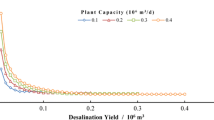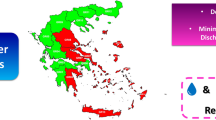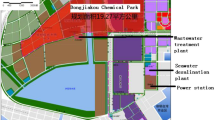Abstract
Anhydrous islands are dependent either on non-conventional water resources, such as desalinated seawater or reclaimed water from wastewater, or on water importation from the mainland. The latter option is often expensive and non-sustainable. Desalinated water can be used for potable and non-potable water applications, while reclaimed water can be used for non-potable water applications. Thus all water needs can be satisfied by an optimal blend of desalinated and reclaimed water. It is important to calculate the optimal capacities and locations of seawater desalination plants, wastewater treatment plants and water reclamation plants, and to estimate the water/wastewater conveyance system, in order to minimise water production and distribution costs. Mathematical modelling and optimisation techniques can be employed for calculating the optimum scenario: the satisfaction of all water needs at minimum cost. In this article, we have estimated the water demands taking into account water quality for the anhydrous Greek island of Syros, in the Aegean Sea. Syros has been subdivided into 6 regions, taking into account geographical and population distribution criteria. All water needs are to be satisfied by desalinated seawater and reclaimed water. A mixed-integer linear programming algorithm is used here to calculate the optimal scenario (location and capacities of desalination plants and wastewater treatment and water reclamation plants, as well as the desalinated water, reclaimed water and wastewater conveyance infrastructure needed) by minimising the annualised total cost including capital and operating costs.









Similar content being viewed by others
References
Assimacopoulos D (2006) Allocation of water resources and cost under scarcity: a case study. Proceedings of the International Workshop on Hydro-Economic Modelling and Tools for Implementation of the European Water Framework Directive, Valencia, Spain
Bakir HA (2001) Sustainable wastewater management for small communities in the Middle East and North Africa. J Environ Manage 61:319–328
Brière FG (2007) Drinking-water distribution, sewage, and rainfall collection, 2nd edn. Presses Internationales Polytechnique, Montréal
Brooke A, Kendrick D, Meeraus A, Raman R (2008) GAMS—a user’s guide. GAMS Development Corporation, Washington, DC
Cunha MC, Pinheiro L, Zeferino J, Antunes A, Afonso P (2009) Optimization model for integrated regional wastewater systems planning. J Water Resour Plan Manage-ASCE 135:23–33
Draper AJ, Jenkins MW, Kirby KW, Lund JR, Howitt RE (2003) Economic-engineering optimization for California water management. J Water Resour Plan Manage-ASCE 129:155–164
Georgopoulou E, Kotronarou A, Koussis A, Restrepo PJ, Gómez-Gotor A, Rodriguez Jimenez JJ (2001) A methodology to investigate brackish groundwater desalination coupled with aquifer recharge by treated wastewater as an alternative strategy for water supply in Mediterranean areas. Desalination 136:307–315
Gikas P, Angelakis AN (2009) Water resources management in Crete and in the Aegean Islands with emphasis on the utilization of non-conventional water sources. Desalination 248:1049–1064
Gikas P, Tchobanoglous G (2009a) The role of satellite and decentralized strategies in water resources management. J Environ Manage 90:144–152
Gikas P, Tchobanoglous G (2009b) Sustainable use of water in the Aegean Islands. J Environ Manage 90:2601–2611
Gillot S, De Clercq B, Defour D, Simoens F, Gernaey K, Vanrolleghem PA (1999) Optimization of wastewater treatment plant design and operation using simulation and cost analysis. Proceedings of Water Environment Federation 72nd Annual Conference and Exposition 1999, New Orleans, Louisiana, October 9–13 1999
Han Y, Xu S, Xu X (2008) Modeling multisource multiuser water resources allocation. Water Resour Manage 22:911–923
Han Y, Huang YF, Wang GQ, Maqsood I (2011) A multi-objective linear programming model with interval parameters for water resources allocation in Dalian city. Water Resour Manage 25:449–463
ILOG (2007) ILOG CPLEX 110 User’s Manual. ILOG SA, Gentilly
Jaber IS, Ahmed MR (2004) Technical and economic evaluation of brackish groundwater desalination by reverse osmosis (RO) process. Desalination 165:209–213
Joksimovic D, Savic DA, Walters GA, Bixio D, Katsoufidou K, Yiantsios SG (2008) Development and validation of system design principles for water reuse systems. Desalination 218:142–153
Kalavrouziotis IK, Apostolopoulos CA (2007) An integrated environmental plan for the reuse of treated wastewater from WWTP in urban areas. Build Environ 42:1862–1868
Khawaji AD, Kutubkhanah IK, Wie J-M (2008) Advances in seawater desalination technologies. Desalination 221:47–69
Law IB (2003) Advanced reuse—from Windhoek to Singapore and beyond. Water May 44-50
Lazarova V, Levine B, Sack J, Cirelli GL, Jeffrey P, Muntau H, Salgot M, Brissaud F (2001) Role of water reuse for enhancing integrated water management in Europe and Mediterranean countries. Water Sci Technol 43(10):25–33
Leitão JP, Matos JS, Gonçalves AB, Matos JL (2005) Contribution of Geographic Information Systems and location models to planning of wastewater systems. Water Sci Technol 52(3):1–8
Li YP, Huang GH, Nie SL (2009) Water resources management and planning under uncertainty: an inexact multistage joint-probabilistic programming method. Water Resour Manage 23:2515–2538
Liu D, Chen X, Lou Z (2010) A model for the optimal allocation of water resources in a saltwater intrusion area: a case study in Pearl River Delta in China. Water Resour Manage 24:63–81
Medellín-Azuara J, Mendoza-Espinosa LG, Lund JR, Ramírez-Acosta RJ (2007) The application of economic-engineering optimisation for water management in Ensenada, Baja California, Mexico. Water Sci Technol 55(1–2):339–347
Okun DA (1997) Distributing reclaimed water through dual systems. J Am Water Work Assoc 89(11):52–64
Wang CG, Jamieson DG (2002) An objective approach to regional wastewater treatment planning. Water Resour Res 38:1022
White I, Falkland T, Perez P, Dray A, Metutera T, Metai E, Overmars M (2007) Challenges in freshwater management in low coral atolls. J Clean Prod 15:1522–1528
World Health Organization (2006) Guidelines for the Safe Use of Wastewater Excreta and Greywater, France, United Nations Environment Program
Xu P, Valette F, Brissaud F, Fazio A, Lazarova V (2001) Technical-economic modelling of integrated water management: wastewater reuse in a French island. Water Sci Technol 43(10):67–74
Zechman EM, Ranjithan RS (2007) Generating alternatives using evolutionary algorithms for water resources and environmental management problems. J Water Resour Plan Manage-ASCE 133:156–165
Acknowledgments
The authors thank Mr. George Vakondios, General Manager of the Water and Wastewater Enterprise of Ermoupolis, for his assistance on the estimation of water demand and wastewater production; and Mr. Nektarios Katsiris, Business Development & Exports Manager of Grundfos Hellas, for his assistance in water and wastewater pumping prising and calculations. S.L. is supported by Overseas Research Students Award Scheme, K.C. Wong Education Foundation, UK Foreign & Commonwealth Office, and Centre for Process Systems Engineering.
Author information
Authors and Affiliations
Corresponding author
Rights and permissions
About this article
Cite this article
Liu, S., Papageorgiou, L.G. & Gikas, P. Integrated Management of Non-conventional Water Resources in Anhydrous Islands. Water Resour Manage 26, 359–375 (2012). https://doi.org/10.1007/s11269-011-9921-z
Received:
Accepted:
Published:
Issue Date:
DOI: https://doi.org/10.1007/s11269-011-9921-z




